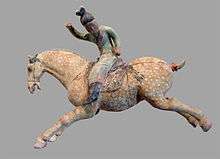Baekje–Tang War
| Baekje-Tang War | |||||||
|---|---|---|---|---|---|---|---|
| |||||||
| Belligerents | |||||||
|
Tang Dynasty Silla |
Baekje Yamato Goguryeo | ||||||
The Baekje–Tang War was fought between Baekje and the allied forces of Tang and Silla between 660 and 663; it was in some respect a spillover of the, at the time, ongoing Goguryeo–Tang War. Silla primarily fought alone in the beginning, incurring significant losses in both manpower and territory. After numerous attacks and raids by the combined forces of Baekje and Goguryeo, King Muyeol sought help from Emperor Gaozong of Tang to defend his exhausted kingdom against the attacks, in return for potential territorial gains. Emperor Gaozong received and granted his request in early 660 and launched the invasion of Baekje. In 668, following a myriad of devastating skirmishes, the kingdoms of Goguryeo and Baekje succumbed to last two combined attacks in late 668 by numerically superior armies of the Tang Dynasty and Silla.
The war effectively marked the end of the Three Kingdoms of Korea period which had lasted since 57 BCE. The period conclusively ended with the concurrent Goguryeo–Tang War.
Background
The Silla kingdom had formed a military alliance with the Tang empire under Emperor Gaozong's reign.[1] When Goguryeo and Baekje attacked Silla from the north and west respectively, Queen Seondeok of Silla had sent an emissary to the Tang empire to desperately request military assistance.[1] In 650, Emperor Gaozong received a poem, written by Queen Seondeok, from the princely emissary Kim Chunchu (who would later accede the Silla throne as King Muyeol).[2] Baekje had allied with Yamato Wa in 653.[3] Even though Baekje was allied with Goguryeo, the Han River valley separated the two states and was a hindrance in coming to each other's aid in time of war.[3] King Muyeol assumed the Silla throne in 654.[4] Between 655 and 659, the border of Silla was harassed by Baekje and Goguryeo; Silla therefore requested assistance from Tang.[5]
Course
In 658, Emperor Gaozong had sent an army to attack Goguryeo.[6] Shortly afterwards, in 660, he sent an army of 130,000 troops towards Baekje to further relieve Silla.[1] During this expedition, Admiral Su Dingfang commanded the Tang fleet and sailed it straight towards Baekje.[2] The Tang fleet sailed across the Yellow Sea,[1] towards Geum River,[2][7] and landed its army on the western coastline of Baekje.[1] After the landing of the army, the 130,000 Tang troops marched further towards Sabi, the capital of Baekje.[5]
Crown Prince Kim Beopmin, General Kim Yusin, General Kim Pumil, and General Kim Heumsun were dispatched to command 50,000 Silla troops and set off westwards into the Battle of Hwangsanbeol.[5] The Silla forces marched into Baekje from the eastern border,[1] and crossed through Sobaek Mountains.[2] General Kim Yusin led the Silla army across the passes of Tanhyon towards Hwangsan Plain.[7] General Gyebaek could only assemble a force of about 5000 Baekje troops in defense against the advancing front of the Silla army.[5] At Hwangsan Plain, the Silla army defeated the Baekje forces of General Gyebaek.[2]
In 660, the Baekje capital Sabi fell to the forces of Tang and Silla.[7][8] Around 10,000 Baekje troops were killed in the siege.[8] Baekje was conquered on 18 July 660,[1] when King Uija of Baekje surrendered at Ungjin.[2] The Tang army took the king, crown prince, 93 officials, and 20,000 troops as prisoner.[8] The king and crown prince were sent as hostages to the Tang empire.[1] The Tang empire annexed the territory and established five military administrations to control the region instead of Silla, which they painfully accepted.[9]
Aftermath
In a final effort, General Gwisil Boksin led the resistance against Tang occupation of Baekje.[10] He requested military assistance from their Yamato allies.[10] In 661, Empress Saimei (also reigned as Empress Kōgyoku) and Prince Naka no Ōe prepared for battle and sent Prince Buyeo Pung of Baekje, who had been in Yamato Wa for over 30 years, to aid the resistance.[10] In 662, they sent an expedition to assist General Gwisil Boksin.[10] A year later, 27,000 Yamato troops were sent as reinforcement.[10] The Tang fleet, comprising 170 ships, advanced towards Chuyu and encircled the city at Baekgang River.[11] As the Yamato fleet engaged the Tang fleet, they were attacked upon by the Tang fleet and were destroyed.[11] In 663, the Baekje resistance and Yamato forces were annihilated by the Tang and Silla forces at the Battle of Baekgang.[12] During the engagement, General Echi no Takutsu was slayed.[11] Subsequently, Prince Buyeo Pung of Baekje and few of his men fled to Goguryeo.[11]
See also
References
Bibliography
- Ebrey, Patricia Buckley; Walthall, Anne; Palais, James B. (2006). East Asia: A cultural, social, and political history. Boston: Houghton Mifflin. ISBN 9780618133840.
- Farris, William Wayne (1985). Population, disease, and land in early Japan, 645-900. Cambridge: Harvard University Press. ISBN 9780674690059.
- Kim, Djun Kil (2005). The history of Korea (1st ed.). Westport: Greenwood Press. ISBN 9780313038532.
- Lee, Kenneth B. (1997). Korea and East Asia: The story of a phoenix. Westport: Praeger. ISBN 9780275958237.
- Ota, Fumio (2012). "The Japanese way of war". The Oxford handbook on war. Corby: Oxford University Press. ISBN 9780199562930.
- Seth, Michael J. (2010). A history of Korea: From antiquity to the present. Lanham: Rowman & Littlefield. ISBN 9780742567177.
- Yu, Chai-Shin (2012). The new history of Korean civilization. Bloomington: iUniverse. ISBN 9781462055593.
